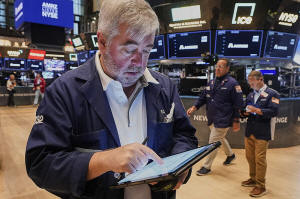Stocks rally and oil tumbles as Wall Street hopes for a limited
retaliation after US strikes on Iran
[June 24, 2025] By
STAN CHOE, ELAINE KURTENBACH and BERNARD CONDON
NEW YORK (AP) — U.S. stocks rallied, and the price of oil tumbled Monday
on hopes that Iran will not disrupt the global flow of crude, something
that would hurt economies worldwide but also its own, following the
United States’ bunker-busting entry into its war with Israel.
The S&P 500 climbed 1%, coming off a week where stock prices had jumped
up and down on worries about the conflict potentially escalating. The
Dow Jones Industrial Average added 374 points, or 0.9%, and the Nasdaq
composite gained 0.9%.
The price of oil initially jumped 6% after trading began Sunday night, a
signal of rising worries as investors got their first chance to react to
the U.S. bombings. But it quickly erased all those gains and swung to a
sharp loss as the focus shifted from what the U.S. military did to how
Iran would react.
By late Monday, the price of a barrel of benchmark U.S. oil had dropped
7.2% to settle at $68.51 after briefly topping $78. That brought it
nearly all the way back to where it was before the fighting began over a
week ago, when it was sitting just above $68.
The losses accelerated sharply after Iran announced a missile attack on
Al Udeid Air Base in Qatar, which the U.S. military uses. Iran said it
matched the number of bombs dropped by the United States on Iranian
nuclear sites this past weekend, which could be a signal of a desire to
deescalate the conflict.

Perhaps most importantly for financial markets, Iran’s retaliation did
not seem to target the flow of oil. The fear throughout the Israel-Iran
war has been that it could squeeze the world’s supply of oil, which
would pump up prices for it, gasoline and other products refined from
crude.
Iran is a major producer of crude, and it could also try to block the
Strait of Hormuz off its coast, through which 20% of the world’s daily
oil needs passes on ships.
Several analysts said Iran would likely not close the waterway because
Iran itself uses the strait to move its own crude, mostly to China, and
it needs the revenue made from such sales of oil.
“It’s a scorched earth possibility, a Sherman-burning-Atlanta move,”
said Tom Kloza, chief market analyst at Turner Mason & Co. “It’s not
probable.”
Neil Newman, managing director of Atris Advisory Japan, said hope
remains that the Israel-Iran war could be a short conflict, with the
thinking being “the one big hit by the Americans will be effective and
then we’ll get back to sort of business as usual, in which case there is
no need for an immediate, panicky type of reaction.”
Of course, not everyone is sure about Iran’s next move.
Andy Lipow, a Houston analyst covering oil markets for 45 years, said
countries are not always rational actors and that he wouldn’t be
surprised if Tehran lashed out for political or emotional reasons.
[to top of second column] |

Trader Edward McCarthy, left, works on the floor of the New York
Stock Exchange, Monday, June 23, 2025. (AP Photo/Richard Drew)
 “If the Strait of Hormuz was
completely shut down, oil prices would rise to $120 to $130 a
barrel,” said Lipow.
“It would mean higher prices for all those goods transported by
truck, and it would be more difficult for the Fed to lower interest
rates.”
The Federal Reserve has been hesitant to cut interest rates this
year because it’s waiting to see how much President Donald Trump’s
tariffs will hurt the economy and raise inflation.
Inflation has remained relatively tame recently, but a rise in oil
and gasoline prices would put upward pressure on it. That in turn
could keep the Fed on hold because cuts to rates can fan inflation
higher, along with giving the economy a boost.
In the bond market, Treasury yields eased after Fed Gov. Michelle
Bowman said she would support cutting rates at the Fed’s next
meeting in just a month, as long as “inflation pressures remain
contained.”
The yield on the 10-year Treasury fell to 4.33% from 4.38% late
Friday. The two-year Treasury yield, which more closely tracks
expectations for the Fed, dropped to 3.84% from 3.90%.
On Wall Street, Elon Musk’s Tesla was the single strongest force
pushing the S&P 500 higher after jumping 8.2%. The electric-vehicle
company began a test run on Sunday of a small squad of self-driving
cabs in Austin, Texas. It’s something that Musk has long been
touting and integral to Tesla’s stock price being as high as it is.
Hims & Hers Health tumbled 34.6% after Novo Nordisk said it will no
longer work with the company to sell its popular Wegovy obesity
drug. Novo Nordisk’s stock that trades in the United States fell
5.5%.
All told, the S&P 500 rose 57.33 points to 6,025.17. The Dow Jones
Industrial Average added 374.96 to 42,581.78, and the Nasdaq
composite gained 183.56 to 19,630.97.
In stock markets abroad, indexes fell modestly across Europe after
finishing mixed in Asia. France’s CAC 40 sank 0.7%, and Hong Kong’s
Hang Seng rose 0.7% for two of the world’s bigger moves.
___
Kurtenbach contributed from Bangkok. AP video journalist Mayuko Ono
in Tokyo and AP Business Writer Matt Ott in Washington contributed.
All contents © copyright 2025 Associated Press. All rights reserved
 |